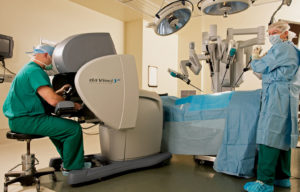The future of surgery offers an amazing cooperation between humans and technology, which could elevate the level of precision and efficiency of surgeries so high we have never seen before.
Will we have Matrix-like small surgical robots? Will they pull in and out organs from patients’ bodies?
The scene is not impossible. It looks like we have come a long way from ancient Egypt, where doctors performed invasive surgeries as far back as 3,500 years ago. Only two years ago, Nasa teamed up with American medical company Virtual Incision to develop a robot that can be placed inside a patient’s body and then controlled remotely by a surgeon.
That’s the reason why I strongly believe surgeons have to reconsider their stance towards technology and the future of their profession.
Surgeons have to rethink their profession
Surgeons are at the top of the medical food chain. At least that’s the impression the general audience gets from popular medical drama series and their own experiences. No surprise there. Surgeons bear huge responsibilities: they might cause irreparable damages and medical miracles with one incision on the patient’s body. No wonder that with the rise of digital technologies, the Operating Rooms and surgeons are inundated with new devices aiming at making the least cuts possible.
We need to deal with these new surgical technologies in order to make everyone understood that they extend the capabilities of surgeons instead of replacing them.
Surgeons also tend to alienate themselves from patients. The human touch is not necessarily the quintessence of their work. However, as technological solutions find their way into their practice taking over part of their repetitive tasks, I would advise them to rethink their stance. Treating patients with empathy before and after surgery would ensure their services are irreplaceable also in the age of robotics and artificial intelligence.
As a first step, though, the society of surgeons has to familiarize with the current state of technology affecting the OR and their job. I talked about these future technologies with Dr. Rafael Grossmann, a Venezuelan surgeon who was part of the team performing the first live operation using medical VR and he was also the first doctor ever to use Google Glass live in surgery.
So, I collected the technologies that will have a huge impact on the future of surgery.
1) Virtual reality
For the first time in the history of medicine, in April 2016 Shafi Ahmed cancer surgeon performed an operation using a virtual reality camera at the Royal London hospital. It is a mind-blowingly huge step for surgery. Everyone could participate in the operation in real time through the Medical Realities website and the VR in OR app. No matter whether a promising medical student from Cape Town, an interested journalist from Seattle or a worried relative, everyone could follow through two 360 degree cameras how the surgeon removed a cancerous tissue from the bowel of the patient.
This opens new horizons for medical education as well as for the training of surgeons. VR could elevate the teaching and learning experience in medicine to a whole new level. Today, only a few students can peek over the shoulder of the surgeon during an operation. This way, it is challenging to learn the tricks of the trade. By using VR, surgeons can stream operations globally and allow medical students to actually be there in the OR using their VR goggles. The team of The Body VR is creating educational VR content as well as simulations aiding the process of traditional medical education for radiologists, surgeons, and physicians. I believe there will be more initiatives like that very soon!
2) Augmented reality
As there is a lot of confusion around VR and AR, let me make it clear: AR differs in two very important features from VR. The users of AR do not lose touch with reality, while AR puts information into eyesight as fast as possible. With these distinctive features, it has a huge potential in helping surgeons become more efficient at surgeries. Whether they are conducting a minimally invasive procedure or locating a tumor in liver, AR healthcare apps can help save lives and treat patients seamlessly.
As it could be expected, the AR market is buzzing. More and more players emerge in the field. Promising start-up, Atheer develops the Android-compatible wearable and complementary AiR cloud-based application to boost productivity, collaboration and output. The Medsights Tech company developed a software to test the feasibility of using augmented reality to create accurate 3-dimensional reconstructions of tumors.
The complex image reconstructing technology basically empowers surgeons with X-ray views – without any radiation exposure, in real time. The True 3D medical visualization system of EchoPixel allows doctors to interact with patient-specific organs and tissue in an open 3D space. It enables doctors to immediately identify, evaluate, and dissect clinically significant structures.
Grossmann also told me that HoloAnatomy, which is using HoloLens to display real data-anatomical models, is a wonderful and rather intuitive use of AR having obvious advantages over traditional methods.
3) Surgical robotics
Surgical robots are the prodigies of surgery. According to market analysis, the industry is about to boom. By 2020, surgical robotics sales are expected to almost double to $6.4 billion.
The most commonly known surgical robot is the da Vinci Surgical System; and believe it or not, it was introduced already 15 years ago! It features a magnified 3D high-definition vision system and tiny wristed instruments that bend and rotate far greater than the human hand. With the da Vinci Surgical System, surgeons operate through just a few small incisions. The surgeon is 100% in control of the robotic system at all times; and he or she is able to carry out more precise operations than previously thought possible.
- Recently, Google has announced that it started working with the pharma giant Johnson&Johnson in creating a new surgical robot system. I’m excited to see the outcome of the cooperation soon. They are not the only competitors, though. With their AXSIS robot, Cambridge Consultants aim to overcome the limitations of the da Vinci, such as its large size and inability to work with highly detailed and fragile tissues. Their robot rather relies on flexible components and tiny, worm-like arms. The developers believe it can be used later in ophthalmology, e.g. in cataract surgery.

4) Minimally Invasive Surgery
Throughout the history of surgery, the ultimate goal of medical professionals was to peak into the workings of the human body and to improve it with as small incisions and excisions as possible. By the end of the 18th century, after Edison produced his lightbulb, a Glasgow physician built a tiny bulb into a tube to be able to look around inside the body.
But it wasn’t until the second half of the 20th century when fiber-optic threads brought brighter light into the caverns of the body. And later, tiny computer chip cameras started sending images back out. At last, doctors could not only clearly see inside a person’s body without making a long incision, but could use tiny tools to perform surgery inside. One of the techniques revolutionizing surgery was the introduction of laparoscopes.
The medical device start-up, Levita aims to refine such procedures with its Magnetic Surgical System. It is an innovative technological platform utilizing magnetic retraction designed to grasp and retract the gallbladder during a laparoscopic surgery.
The FlexDex company introduced a new control mechanism for minimally invasive tools. It transmits movement from the wrist of the surgeon to the joint of the instrument entirely mechanically and it costs significantly less than surgical robots.
5) 3D Printing and simulations in pre-operative planning and education
Complicated and risky surgeries lasting hours need a lot of careful planning. Existing technologies such as 3D printing or various simulation techniques help a lot in reforming medical practice and learning methods as well as modelling and planning successfully complex surgical procedures.
In March 2016 in China, a team of experienced doctors decided to build a full-sized model of the heart of a small baby born with a heart defect. Their aim was to pre-plan an extremely complicated surgery on the tiny heart. This was the first time someone used this method in China. The team of medical professionals successfully completed the surgery. The little boy survived with little to no lasting ill-effects.
In December 2016, in the United Arab Emirates doctors have used 3D printing technology for the first time to help safely remove a cancerous tumour from a 42-year-old woman’s kidney. With the help of the personalized, 3D printed aid the team was able to carefully plan the operation as well as to reduce the procedure by an entire hour!
The technology started to get a foothold also in medical education. To provide surgeons and students with an alternative to a living human being to work on, a pair of physicians at the University of Rochester Medical Center (URMC) have developed a way to use 3D printing to create artificial organs. They look, feel, and even bleed like the real thing. Truly amazing!
To widen the platform of available methods for effectively learning the tricks of the trade, Touch Surgery developed a simulation system. It is basically an app for practicing procedures ranging from heart surgery to carpal tunnel operations.
6) Live diagnostics
The intelligent surgical knife (iKnife) was developed by Zoltan Takats of Imperial College London. It works by using an old technology where an electrical current heats tissue to make incisions with minimal blood loss. With the iKnife, a mass spectrometer analyzes the vaporized smoke to detect the chemicals in the biological sample. This means it can identify whether the tissue is malignant real-time.
The technology is especially useful in detecting cancer in its early stages and thus shifting cancer treatment towards prevention.
7) Arfificial Intelligence will team up with surgical robotics
Catherine Mohr, vice president of strategy at Intuitive Surgical and expert in the field of surgical robotics believes surgery will take to the next level with the combination of surgical robotics and artificial intelligence. She is thrilled to see IBM Watson, Google Deepmind’s Alpha Go or machine learning algorithms to have a role in surgical procedures. She envisioned a tight partnership between humans and machines, with one making up for the weaknesses of the other.
In my view, AI such as the deep learning system, Enlitic, will soon be able to diagnose diseases and abnormalities. It will also give surgeons guidance over their – sometimes extremely – difficult surgical decisionI agree with Dr. Mohr in as much as I truly believe the future of surgery, just as the future of medicine means a close cooperation between humans and medical technology. I also cannot stress enough times that robots and other products of the rapid technological development will not replace humans. The two will complement each other’s work in such a successful way that we had never seen nor dreamed about before. But only if we learn how.
The Future of Surgical Technology by Dr. Bertalan Meskó

